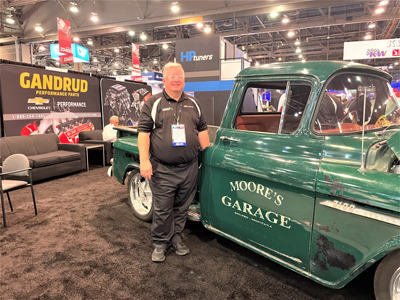Chris Slack manages a parts department at Ivan Gandrud Chevrolet in Green Bay, WI, that employs 30 people, including eight counter people and three service technicians.
The department carries an inventory of approximately $5.5 million, consisting of mechanical, collision and performance parts, and is an authorized Mopar dealer that sells genuine Mopar parts online.
With 30-plus years of experience under his belt, Slack is succeeding in a very competitive marketplace. He’s well-known for being one of GM’s largest parts operations in the country, serving all of Wisconsin and part of Michigan with a fleet of 18 trucks.
Gandrud has been exhibiting at SEMA for the past four years, after attending it the four years before that. Autobody News asked him about the show and its impact on his business.
What were the central issues that shops and parts suppliers were dealing with in 2022?
We have been dealing with a bunch of issues but the biggest is backordered parts. So many parts are unavailable from the manufacturer. We have been trying to make it seamless by buying parts for our customers from other dealers across the country. We have bought more parts from other dealers than ever before, but if that's what it takes to get a car finished and out of our customer's shop, then that's what we have to do.
Do you see value in a show like SEMA for dealer parts suppliers?
SEMA is a great show for us because we have a large Chevrolet Performance parts business. We see a lot of our performance and collision customers at the show so that is nice also.
How has SEMA changed since your first show?
I think SEMA has changed from a performance show to a more complete automotive show. Now even the service manager and the collision shop manager should attend and visit all the vendors and attend training.
Do you think parts availability will improve significantly in 2023?
No, maybe by the end of 2023, availability is improving but very, very slowly.
Those are definitely the three top concerns. We need a bigger facility because we need more inventory which means more people and more delivery drivers. We have had to cut back on our delivery area because we don't have time to deliver to all our customers.
What will your sector look like in 2025?
I think there will be fewer collision shops and also fewer wholesale parts dealers.
The parts dealers are under a lot of pressure right now. Our discounts from the manufacturers have dropped because of availability---many parts can no longer be ordered at a truckload discount but instead we have to special order it one at a time to get the part at a much lower discount. Delivery expenses have gone up, personal costs have gone up.
But as the large MSOs buy up all the collision shops, they are demanding bigger discounts. That's a business model that doesn't work. The collision shops should instead work on getting a higher labor rate from the businesses that control that.
If a young person was going to enter this industry, what would you tell them?
Now is a great time to get into the parts and collision business. Demand for qualified people has never been higher. Every collision shop and wholesale parts department in the state is hiring right now.










Ed Attanasio